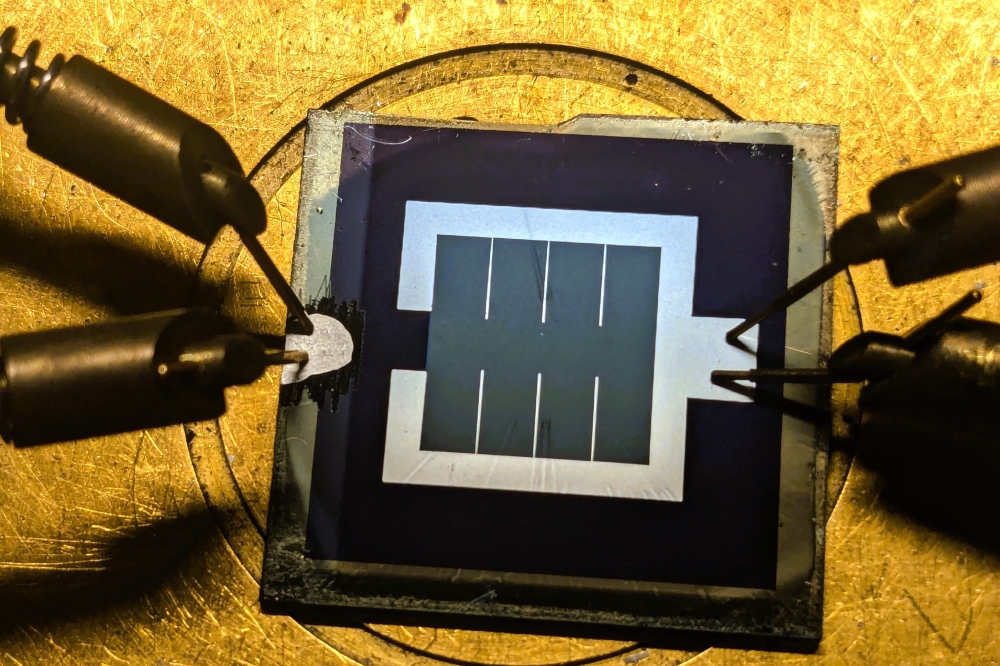Scrutinising growth

Reflection anisotropy spectroscopy exposes defects and anti-phase domains that can destroy the performance of III-V- on-silicon devices
BY OLIVER SUPPLIE, SEBASTIAN BRUECKNER, MATTHIAS M. MAY AND THOMAS HANNAPPEL FROM TU ILMENAU
WHETHER IT IS MULTI-JUNCTION PHOTOVOLTAICS, microelectronics or photonics, the integration of III-Vs with silicon offers the best of both worlds. Armed with this combination, one can harness the sensational characteristics of the compounds while accessing the size and lower cost of silicon. But how should one go about doing this?
When it comes to the selection of the growth technology, the number one candidate has to be MOCVD. Its high-volume capability is highlighted by its use in the production of myriad LEDs, while its suitability for growing III-Vs on silicon is already showing encouraging signs. However, to accelerate progress in this field, it is essential that engineers gain a better understanding of the growth of these III-V-on-silicon heterostructures, including the complex physico-chemical processes and interface formations. This knowledge should make it easier to grow these challenging epistructures.
One way to get this insight is to use optical spectroscopy to study epitaxial growth. This allows in-situ monitoring of interface formations and growth processes on the atomic scale in the vapour phase conditions used for deposition.
There are several forms of optical spectroscopy to choose from, including a technique known as reflection anisotropy spectroscopy. This is tough to understand, and it is not easy to employ it for analysis. However, those that are willing to make the effort are well rewarded. In fact, the information gathered by this approach is so rich that it would be reprehensible not to utilize it.
One of the distinguishing features of reflection anisotropy spectroscopy is that, unlike many reflection measurements, differences in reflection are measured along two mutually perpendicular crystal directions. This gives this form of spectroscopy tremendous atomic-scale sensitivity to the surfaces and the interfaces of cubic crystals "“ and particularly those with the (100) orientation. However, making good use of the spectra requires an understanding of their origin "“ and this means combining the physico-chemically complex environment of MOCVD with the world of interfacial science, usually based on ultra-high vacuum periphery. Fortunately, these two can be linked by a dedicated, contamination-free transfer system.
Our team from the Technical University of Illmenau, Germany, focuses on the benchmarking of in-situ reflection anisotropy spectra. This involves using all the tools available in high-end analytics, including low-energy electron diffraction (LEED), scanning tunnelling microscopy (STM), Fourier-transform infrared spectroscopy (FTIR) and photoelectron spectroscopies (PES).
The experimental approach of the team at TU Illmenau consists of in-situ monitoring of the MOCVD processes (Aixtron AIX-200) with reflection anisotropy spectroscopy (Laytec EpiRAS-200) and a contamination-free MOCVD-to-UHV transfer for benchmarking of the in-situ signals to surface science techniques in UHV, such as STM (Specs Aarhus 150).
One of our strengths is that we can bridge the gap of more than ten orders of magnitude in pressure within a matter of seconds. We realise this with a mobile, ultra-high vacuum shuttle that enables us to access essentially any UHV chamber "“ this could be in our labs, or at remote locations such as synchrotron facilities. With the in-situ signature, we can carry the atomic scale information, together with the reflection anisotropy spectrometer, from one laboratory to the next. As this form of spectroscopy is also applicable in ultra-high vacuum environments, we can determine whether surfaces remain intact after further analysis.
Silicon surfaces
We can showcase the benefits of our approach by recounting the success that we have had with growth on the silicon (100) surface. Deposition of III-Vs on this substrate can induce defects during preparation and III-V nucleation. These imperfections are a major impediment to the performance of optoelectronic devices, because they are responsible for non-radiative recombination.
Another issue with the growth of III-Vs on silicon (100) is that it can lead to antiphase disorder, caused by oddly numbered atomic step heights at the substrate surface, where silicon dimers on adjacent terraces are mutually perpendicular.
The good news, however, is that the monohydride silicon (100) surface exhibits a characteristic reflection anisotropy spectroscopy signal that is related to the silicon dimers "“ and the intensity of this signal corresponds to the number of parallel-aligned dimers. Reflection anisotropy spectroscopy is able to provide an in-situ quantification of the majority dimer orientation, and by selecting the photon energy of that signal during surface preparation, it is possible to employ process conditions that produce single-domain surfaces.
We have observed a transient reflection anisotropy signal during annealing of silicon (100) with a 2° misorientation towards [011]. Conditions for this were 730 °C in a hydrogen gas environment held at 950 mbar. We observed a strengthening of the intensity of this signal, due to an increase in the proportion of the surface exhibiting the (1x2) surface rearrangement, as confirmed by LEED, FTIR and STM.
Figure 1. Transient reflection anisotropy spectra during the formation of an almost single-domain silicon (100)-(1x2) surface. The inset shows the scanning tunnelling microscopy image of such a surface. The sketch at the right illustrates the formation process consisting of silicon vacancy generation, anisotropic diffusion and annihilation at the end of the dimer rows.
There is an activation energy associated with this surface reconstruction, according to in-situ measurements at different temperatures "“ and this is consistent with chemical interfacial reactions induced by hydrogen. The conclusion to draw from this is that kinetically controlled surface etching processes are taking place, via the formation of SiHx species.
Combining these findings with STM and in-situ hydrogen desorption studies reveals that the generation of silicon vacancies should be blamed on continuous adsorption and desorption of hydrogen. These vacancies are mobile, moving preferentially along dimer rows, where they annihilate at step edges. This causes a retreat of the (2x1) domains, with only small residuals left at the step edges, as verified by STM images (see the inset of Figure 1).
Our studies with transient reflection anisotropy spectroscopy have uncovered process conditions that lead to domain imbalances with ratios as high as 85:15. Such a surface is able to highly suppress antiphase disorder within the very first III-V epilayers. What's more, we can quantify that imbalance in-situ, allowing us to adjust the conditions before we start to nucleate III-Vs.
On larger terraces we have performed analogous experiments. This study includes almost exactly oriented silicon (100), where we observe a completely different behaviour: The reflection anisotropy spectroscopy transient oscillates, with constant period and decreasing intensity. From STM and LEED measurements, we know that a flip of the sign of the signal implies a rotation of the preferential silicon dimer orientation. So what we are witnessing is a periodic change from (1x2) to (2x1) domains.
This situation arises due to layer-by-layer removal of silicon atoms. It is believed to occur when vacancies group to vacancy islands (see Figure 2) "“ and once they reach a certain size, vacancies may also be created within the vacancy island, such as at the subjacent layer. The continuation of this process accounts for the oscillation of this signal, which gets weaker as more and more residuals are left over to leave a two-domain surface with frayed step edges (see Figure 2).
Figure 2. Transient reflection anisotropy spectra during layer-by-layer removal at silicon (100). The left scanning tunnelling microscopy image shows a preferential (1x2)-type surface with elongated silicon vacancy islands. The right scanning tunnelling microscopy image shows frayed step edges at a two-domain surface after longer annealing.
Adding III-Vs
When it comes to the growth of III-Vs on silicon, most surfaces that might be suitable for growth have characteristic reflection anisotropy spectra. This is certainly true for GaP, which can be grown pseudomorphically on silicon (100). Although this III-V might not be used to build a device, single-domain GaP/silicon (100) surfaces − where complications arising from the polar-on-non-polar transition between a III-V epilayer and a group IV substrate are already solved − are a great starting point for a transition to other III-Vs.
Reflection anisotropy spectroscopy offers an insight into the entire process, from silicon preparation to GaP nucleation and formation of a surface of this material (see Figure 3). We can monitor signals providing information about the atomic order at the surface and the thickness of the epilayer and heterointerface. This data allows optimization of each process step, and holds the key to the formation of very flat, single-domain quasi-substrates. According to ex-situ atomic force microscopy measurements, the roughness of this surface, evaluated in terms of root-mean-square roughness, is typically in the range of a few Angstrom.
Preparing these well-defined, sharp interfaces is highly beneficial. It improves the performance of many classes of device, including those that feature tunnel junctions; and it allows the construction of structures incorporating III-Vs on either germanium or silicon. For example, reflection anisotropy spectroscopy allows control of the preparation of single-domain vicinal germanium (100) surfaces.
Development of quadruple-junction cells, which are taking efficiencies to new highs, have also been aided by reflection anisotropy spectroscopy. This technique has helped to develop, on InP (100), a photovoltaic tandem subcell that is optimized to absorb the infrared part of the solar spectrum within a four-junction cell.
It is clear that reflection anisotropy spectroscopy can play a major role in assisting the epitaxial growth of III-Vs, silicon, and germanium. Once spectra are established, it is easy to refer to them when growing challenging structures. They are undoubtedly proving indispensable for the growth of III-Vs on silicon, which involves competition between thermodynamic driving forces and kinetically limiting interfacial reactions such as adsorption, desorption and etching reactions that lead to a highly complex, interfering preparation scenario.
Figure 3. Reflection anisotropy spectra of silicon (100) (black), after pulsed GaP nucleation and of the final phosphor-rich GaP/silicon (100) surface of 0.04 µm-thick single-domain epilayer. The insets indicate a top view of the surface reconstruction of silicon (100) and GaP/ silicon (100), respectively. The ball-and-stick model on the right hand side sketches the layer stack for a double-layer step at the silicon surface assuming abrupt interfaces.


































